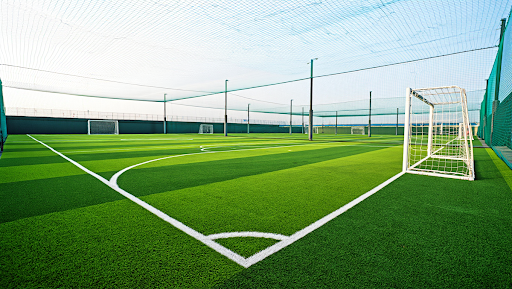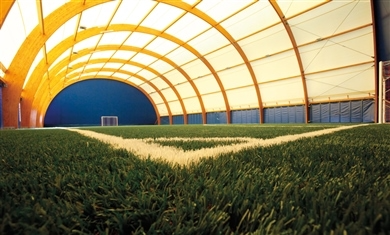Futsal fields: Dimensions, Construction, and Surfaces
Futsal, a dynamic and fast-paced variation of soccer, has captured the hearts of athletes and fans across the United States. Played on a smaller, hard field, futsal emphasizes technical skill, quick thinking, and rapid ball movement. If you're looking to understand, build, or upgrade a futsal field, you've come to the right place.
- Futsal field dimensions: official standards and adaptations
- Futsal field surfaces: the heart of the game
- Common futsal field materials
- Futsal field construction: from concept to kick-off
- Our comprehensive service

Futsal field dimensions: official standards and adaptations
A futsal field, also known as a futsal field, has specific dimensions that can vary depending on the level of play. Whether you're planning for international competition or a local league, understanding these measurements is key.
International futsal field dimensions
For international matches, futsal fields adhere to strict guidelines:
- Length: 38 to 42 meters (approximately 125 to 138 feet)
- Width: 20 to 25 meters (approximately 66 to 82 feet)
Non-International futsal field dimensions
For non-international matches, there's a bit more flexibility, allowing for adaptation to various indoor and outdoor spaces:
- Length: 25 to 42 meters (approximately 82 to 138 feet)
- Width: 16 to 25 meters (approximately 52.5 to 82 feet)
Key field features and markings
All futsal fields share essential features and markings:
- Lines: The field is clearly marked with touchlines (the longer boundaries) and goal lines (the shorter boundaries). All lines are typically 8 cm (3.15 inches) wide.
- Center Line: Divides the field into two equal halves.
- Center Circle: A circle with a radius of 3 meters (9.8 feet) surrounds the center mark.
- Penalty Areas: Defined by semi-circular arcs with a radius of 6 meters (19.7 feet) drawn from the goal posts.
- Penalty Marks: The first penalty mark is 6 meters from the midpoint of the goal line, and a second penalty mark is 10 meters from the midpoint.
- Substitution Zones: Designated areas on the touchline for player substitutions, typically 5 meters (16.4 feet) in length.
Futsal goal dimensions
Futsal goals are distinct from traditional soccer goals due to the smaller field size and faster play. They are typically 2 meters (6.6 feet) high and 3 meters (9.8 feet) wide, designed to fit perfectly within the goal lines and ensure exciting gameplay.
field adaptations for various facilities
One of the reasons futsal is so popular is its adaptability. Schools, community centers, and other facilities often utilize modified field sizes to fit existing indoor spaces, such as gymnasiums, making the sport accessible to a wider audience.
Futsal field surfaces: the heart of the game
The playing surface is crucial for the unique characteristics of futsal. Born in Uruguay in the late 20th century, futsal's emphasis on technical skill and speed demands a surface that enhances these aspects.
Ideal futsal surface characteristics
A high-quality futsal surface must ensure:
- Controlled Ball Rebound: Essential for quick, technical play.
- Speedy Player Movements: Allows for agile footwork and rapid changes in direction.
- Fluid Ball Sliding: Enhances the spectacular, continuous flow of the game.

Common futsal field materials
The playing surface of a futsal field can be made from various materials, provided they are flat, smooth, and non-abrasive:
- Artificial Material (Synthetic Turf): Increasingly popular for its performance and durability.
- Wood: Often found in gymnasiums, providing excellent ball control and player comfort.
- Concrete or Asphalt: Common for outdoor or multi-purpose fields.
Why synthetic turf is a top choice for futsal
Synthetic turf has emerged as a premier surface for futsal fields due to its numerous advantages:
- Shock Absorption: Minimizes impact on players, reducing the risk of injuries from falls.
- Reduced Abrasion: Less skin irritation from slides and falls compared to rougher surfaces.
- Natural Feeling & Aesthetics: Provides a consistent playing experience with an appealing visual effect.
- Optimal Slide: Ensures the ball moves fluidly, maintaining the fast pace of the game.
- Minimum Maintenance: Significantly less upkeep required compared to natural grass.
- All-Year Availability: Playable in any climate condition, ensuring continuous access to the field.
Futsal field construction: from concept to kick-off
Whether you're planning a brand-new facility or renovating an existing space, constructing a futsal field is an investment in community and sport.
The Italgreen advantage: pioneers in futsal turf
Italgreen has been at the forefront of futsal turf technology for over 30 years, being the first European company to install synthetic futsal turf. Our extensive experience and continuous research ensure high-performing surfaces with excellent visual appeal, designed to meet the demanding feedback of players and coaches. Today, synthetic grass futsal turf is a globally recognized and widespread technology.
Our comprehensive futsal field services
We offer complete futsal turf systems for both professional indoor playing and outdoor fields. Our multi-purpose surfaces are ideal for creating efficient futsal fields for both experienced and amateur play.
When you choose Italgreen, you benefit from a complete service:
- Project Design: Expert planning for your new or renovated field.
- Best Futsal Turf Selection: Guidance in choosing the ideal synthetic turf system from our wide product range.
- Complete Installation: Professional installation of the turf and all necessary auxiliary structures.
We focus on optimizing installation and maintenance costs, ensuring you get the best value without compromising on quality. Once your field is complete, all you'll need to do is put on your shoes and start playing!
Futsal turf is truly growing at Italgreen, and we're ready to help you bring the excitement of the game to your community.
- Via Crusnigo, 11
- 24030 Villa d'Adda (Bergamo)
- VAT number: IT01640880165
- Cod. Fiscale 07075130158
- Cod. Destinatario SUBM70N
- Shared capital: € 5,000,000
- REA BG 214799
- Phone number: +39 (035) 784-178
- Fax: +39 (035) 784-144
- Email: contact@italgreen.it
- PEC: italgreen@mailcertificata.org
- CLICK HERE to Whistleblowing

- Padel
- Artificial lawn
- Padel courts: benefits, construction and installation
- Build a tennis court: the complete guide by Italgreen
- Artificial grass manufacturers and suppliers
- Synthetic grass tennis court: benefits and supply
- Padel
- Artificial grass for sports
- Artificial grass manufacturers
- Sports artificial grass
- Synthetic grass manufacturer
- Italgreen: golf turf manufacturers and suppliers since 1983
- NEW LIMITED EDITION PADEL COURTS
- Padel court manufacturers: why choose Italgreen
- Sports turf manufacturers since 1983
- Indoor padel courts
- Italgreen’s synthetic soccer field
- The steps to replace the synthetic grass for padel
- Hybrid Turf
- High-quality artificial sports turf manufacturer
- Padel court supplier
- Artificial grass factory: Italgreen is at your disposal
- Soccer turf installation: a guide by Italgreen
- Padel court maintenance
- Synthetic Turf Suppliers
- Padel court builder: Italgreen is the solution
- Comprehensive guide to synthetic soccer turf: benefits, installation, and maintenance
- Field hockey turfs: a comprehensive guide
- Padel Court Design, Project, and Installation
- Artificial football turf